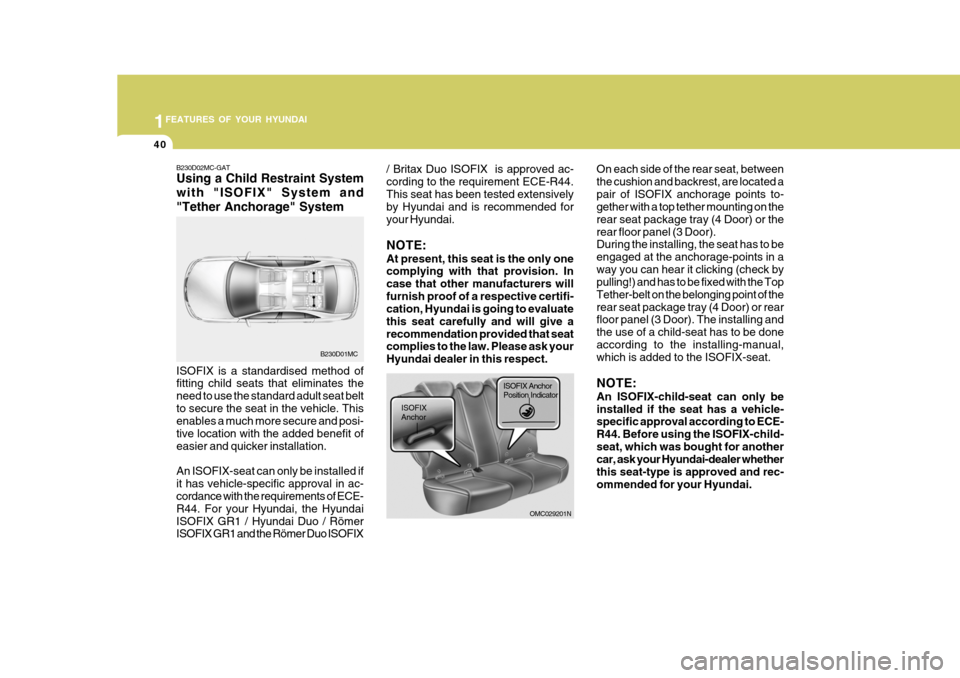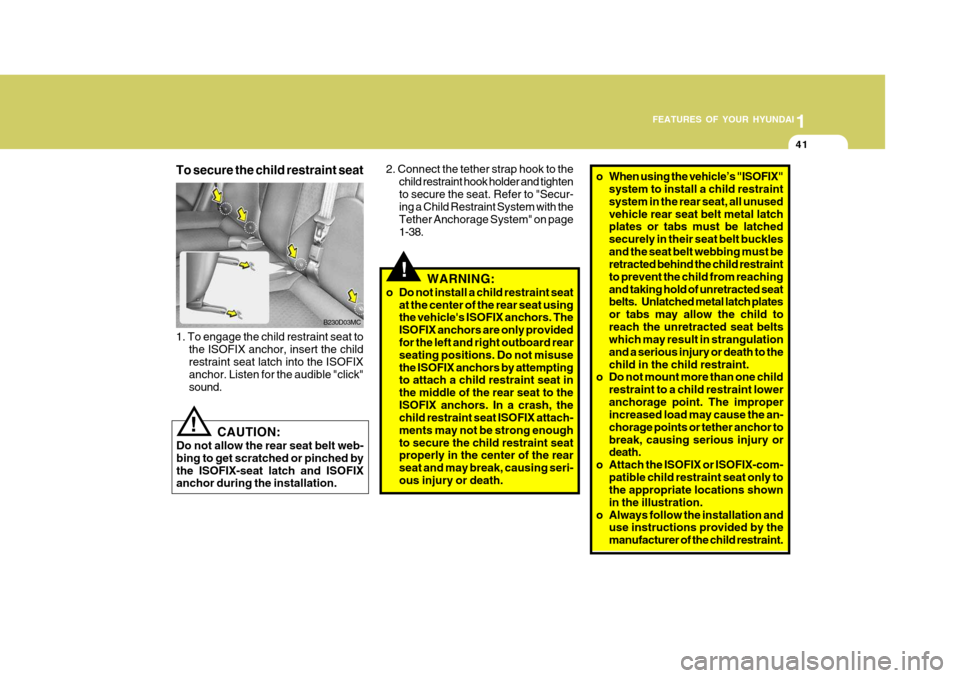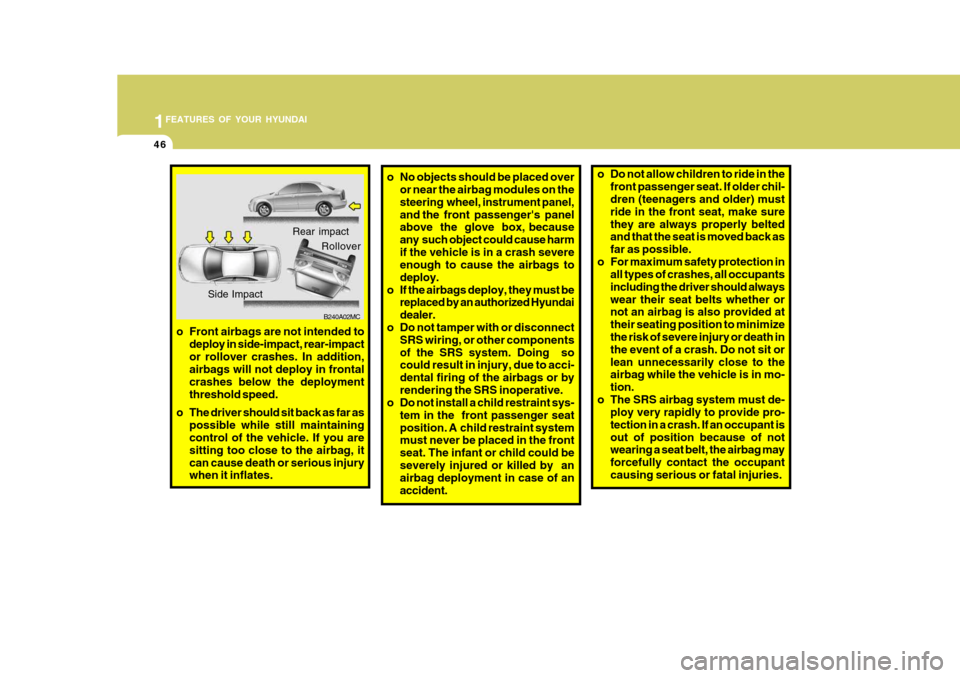2010 Hyundai Accent child seat
[x] Cancel search: child seatPage 50 of 284

1FEATURES OF YOUR HYUNDAI
38
B230B01NF
Child Restraint Hook Holder Spacer
B230B02A-GAT Using a Child Restraint System with "Tether Anchorage" Sys-tem For small children and babies, the use of a child seat or infant seat is required. This child seat or infant seat should be of appropriate size for the child andshould be installed in accordance with the manufacturer's instructions. It is further required that the seat be placedin the vehicle's rear seat since this can make an important contribution to safety. Your vehicle is provided withthree child restraint hook holders for installing the child seat or infant seat. Holder Bolt (5/16"-22 mm) Conical Spring Washer Child Restraint Hook Holder Retainer Washer
!WARNING:
We recommends that a child restraint seat be installed in the rear seat, even if the passenger's front airbagswitch is set to "OFF". To ensure the safety of your child, the passenger's front airbag must bedeactivated when it should be neces- sary to install a child restraint seat on the front passenger seat in excep-tional circumstances. B230C03A-GAT Securing a Child Restraint Sys- tem with "Tether Anchorage"System (4 Door) Three child restraint hook holders are located on the rear seat package tray.
1. Open the tether anchor cover on the
rear seat package tray.
B230C01MC
Page 51 of 284

1
FEATURES OF YOUR HYUNDAI
39
B230C02MC
2. Route the child restraint seat strap over the seatback. For vehicles with adjustable head- rests, route the tether strap under theheadrest and between the headrest posts, otherwise route the tether strap over the top of the seatback.
3. Connect the tether strap hook (2) to the child restraint hook holder (1) and tighten to secure the seat.
B230E01MC-GAT Securing a Child Restraint Sys- tem with "Tether Anchorage" System (3 Door) Three child restraint hook holders are located on the rear floor panel.
2. Route the child restraint seat strap
over the seatback. For vehicles with adjustable head- rests, route the tether strap under theheadrest and between the headrest posts, otherwise route the tether strap over the top of the seatback.
3. Connect the tether strap hook (2) to the child restraint hook holder (1) andtighten to secure the seat. B230C02MC
1. Open the tether anchor cover on therear floor panel.
B230E01MC
Page 52 of 284

1FEATURES OF YOUR HYUNDAI
40
B230D02MC-GAT Using a Child Restraint System with "ISOFIX" System and"Tether Anchorage" System ISOFIX is a standardised method of fitting child seats that eliminates the need to use the standard adult seat beltto secure the seat in the vehicle. This enables a much more secure and posi- tive location with the added benefit ofeasier and quicker installation. An ISOFIX-seat can only be installed if it has vehicle-specific approval in ac- cordance with the requirements of ECE- R44. For your Hyundai, the HyundaiISOFIX GR1 / Hyundai Duo / Römer ISOFIX GR1 and the Römer Duo ISOFIX
B230D01MC / Britax Duo ISOFIX is approved ac- cording to the requirement ECE-R44.This seat has been tested extensively by Hyundai and is recommended for your Hyundai. NOTE: At present, this seat is the only one complying with that provision. In case that other manufacturers willfurnish proof of a respective certifi- cation, Hyundai is going to evaluate this seat carefully and will give arecommendation provided that seat complies to the law. Please ask your Hyundai dealer in this respect.
OMC029201N
ISOFIX Anchor
ISOFIX Anchor Position Indicator On each side of the rear seat, between the cushion and backrest, are located apair of ISOFIX anchorage points to- gether with a top tether mounting on the rear seat package tray (4 Door) or therear floor panel (3 Door). During the installing, the seat has to be engaged at the anchorage-points in away you can hear it clicking (check by pulling!) and has to be fixed with the Top Tether-belt on the belonging point of therear seat package tray (4 Door) or rear floor panel (3 Door). The installing and the use of a child-seat has to be doneaccording to the installing-manual, which is added to the ISOFIX-seat. NOTE: An ISOFIX-child-seat can only be installed if the seat has a vehicle- specific approval according to ECE- R44. Before using the ISOFIX-child-seat, which was bought for another car, ask your Hyundai-dealer whether this seat-type is approved and rec-ommended for your Hyundai.
Page 53 of 284

1
FEATURES OF YOUR HYUNDAI
41
o When using the vehicle’s "ISOFIX"
system to install a child restraint system in the rear seat, all unusedvehicle rear seat belt metal latch plates or tabs must be latched securely in their seat belt bucklesand the seat belt webbing must be retracted behind the child restraint to prevent the child from reachingand taking hold of unretracted seat
belts. Unlatched metal latch plates or tabs may allow the child toreach the unretracted seat belts which may result in strangulation and a serious injury or death to thechild in the child restraint.
o Do not mount more than one child
restraint to a child restraint loweranchorage point. The improper increased load may cause the an- chorage points or tether anchor tobreak, causing serious injury or death.
o Attach the ISOFIX or ISOFIX-com- patible child restraint seat only tothe appropriate locations shown in the illustration.
o Always follow the installation and use instructions provided by themanufacturer of the child restraint.
WARNING:
o Do not install a child restraint seat at the center of the rear seat using the vehicle's ISOFIX anchors. The ISOFIX anchors are only provided for the left and right outboard rear seating positions. Do not misusethe ISOFIX anchors by attempting to attach a child restraint seat in the middle of the rear seat to theISOFIX anchors. In a crash, the child restraint seat ISOFIX attach- ments may not be strong enoughto secure the child restraint seat properly in the center of the rear seat and may break, causing seri-ous injury or death.
B230D03MC
1. To engage the child restraint seat to the ISOFIX anchor, insert the childrestraint seat latch into the ISOFIX anchor. Listen for the audible "click" sound.
To secure the child restraint seat!
2. Connect the tether strap hook to the
child restraint hook holder and tighten to secure the seat. Refer to "Secur- ing a Child Restraint System with the Tether Anchorage System" on page1-38.
! CAUTION:
Do not allow the rear seat belt web- bing to get scratched or pinched bythe ISOFIX-seat latch and ISOFIX anchor during the installation.
Page 58 of 284

1FEATURES OF YOUR HYUNDAI
46
o Do not allow children to ride in the
front passenger seat. If older chil- dren (teenagers and older) must ride in the front seat, make surethey are always properly belted and that the seat is moved back as far as possible.
o For maximum safety protection in all types of crashes, all occupantsincluding the driver should alwayswear their seat belts whether or not an airbag is also provided at their seating position to minimize the risk of severe injury or death in the event of a crash. Do not sit orlean unnecessarily close to the airbag while the vehicle is in mo- tion.
o The SRS airbag system must de- ploy very rapidly to provide pro-tection in a crash. If an occupant isout of position because of not wearing a seat belt, the airbag may forcefully contact the occupantcausing serious or fatal injuries.o No objects should be placed overor near the airbag modules on the steering wheel, instrument panel,and the front passenger's panel above the glove box, because any such object could cause harmif the vehicle is in a crash severe enough to cause the airbags to deploy.
o If the airbags deploy, they must be replaced by an authorized Hyundaidealer.
o Do not tamper with or disconnect SRS wiring, or other componentsof the SRS system. Doing so could result in injury, due to acci- dental firing of the airbags or byrendering the SRS inoperative.
o Do not install a child restraint sys-
tem in the front passenger seatposition. A child restraint system must never be placed in the front seat. The infant or child could beseverely injured or killed by an airbag deployment in case of an accident.
o Front airbags are not intended todeploy in side-impact, rear-impact or rollover crashes. In addition, airbags will not deploy in frontal crashes below the deploymentthreshold speed.
o The driver should sit back as far as possible while still maintaining control of the vehicle. If you are sitting too close to the airbag, itcan cause death or serious injury when it inflates.
B240A02MC
Rear impact
Side Impact Rollover
Page 61 of 284

1
FEATURES OF YOUR HYUNDAI
49
o The SRS can function only when
the ignition key is in the "ON" position. If the SRS is not working properly,(1) The SRS SRI does not come on
when the ignition key is turnedto the "ON" position or after the engine is started.
(2) The SRS SRI blinks for a sec- ond and remains on after illu-minating for about 6 secondswhen the ignition key is turned to the "ON" position or after the engine is started.
(3) The SRS SRI illuminates while driving.
If this occurs, have your vehicleimmediately inspected by your Hyundai dealer.
o Before you replace a fuse or dis- connect a battery terminal, turnthe ignition key to the "LOCK" position or remove the ignitionkey. Never remove or replace the air bag related fuse(s) when the ignition key is in the "ON" posi-tion. Failure to heed this warning will cause the SRS SRI to illumi- nate.B990A02MC-GAT Passenger's Front Airbag ON/ OFF Switch (If Installed)
B990A01MC
The passenger's front airbag can be deactivated by the passenger's frontairbag ON/OFF switch (1) if a child restraint is installed on the front passenger's seat or if the frontpassenger's seat is unoccupied by a person. To ensure the safety of your child, thepassenger's front airbag must be deac- tivated when it should be necessary to install a rearward facing child seat onthe front passenger seat in exceptional circumstances. (1)
!WARNING:
The front air bag ON/OFF switch could turn by using a similar small rigid device. Always check the status of the front air bag ON/OFF switchand passenger's front air bag OFF indicator.
Page 63 of 284

1
FEATURES OF YOUR HYUNDAI
51
B990B01MC-AAT Side Impact Airbag (If Installed) Your Hyundai is equipped with a side impact airbag in each front seat. The purpose of the airbag is to provide thevehicle's driver and/or the front passen- ger with additional protection than that offered by the seat belt alone. The sideimpact airbags are designed to deploy only during certain side impact colli- sions, depending on the crash severity,angle, speed and point of impact. The side impact airbags are not designed to deploy in all side impact situations.
B990B02LZ
o Even though your vehicle is equipped with the passenger's airbag ON/OFF switch, do not in-stall a child restraint system in the front passenger's seat. A child re- straint system must never beplaced in the front seat. Children who are too large for child re- straint systems should alwaysoccupy the rear seat and use the available lap/shoulder belts. Chil- dren are afforded the most safetyin the event of an accident when they are restrained by a proper restraint system in the rear seat.
o As soon as deactivation is no longer needed, reactivate the frontpassenger's airbag.!WARNING:
o The driver is responsible for the proper position of the passenger's front airbag ON/OFF switch.
o Deactivate the front passenger's
airbag only when the ignitionswitch is switched off, or the mal- function may occur in the SRSCM (SRS Control Module). And theremay be a danger that the driver's and/or passenger's front and/or side and curtain airbag may fail totrigger, or not trigger correctly during a collision.
o Never install a rearward facing
child seat on the front passenger'sseat. The infant or child could be severely injured or killed by anairbag deployment in case of an accident.
Page 65 of 284

1
FEATURES OF YOUR HYUNDAI
53
!WARNING:
o Before installing child restraints , always refer to “Child Restraint System” section to ensure correctinstallation and that occupant pro- tection is maximized.
o Make sure that the occupant does not have any body parts (head,arms & legs) protruding outside the restraining system. If an inflat-ing airbag was to strike an infant or child, it may cause serious in- jury.
o Ensure the opening for the Cur- tain Airbag System remains unob-structed at all times, so that theairbags can inflate properly if needed.
o The built in coat hooks should only be used for light weight cloth-ing, ensure that pockets are free of any heavy or sharp objects. Whenusing coat hooks, do not hang clothes on coat hangers.
Important Safety Notes for Cur- tain Airbag Systems Following are a number of safety points concerning this system which shouldalways be observed to ensure risk of injury is reduced in an accident.
B990C01JM-GAT Curtain Airbag (If Installed)
Curtain airbags are located along both sides of the roof rails above the front and rear doors.They are designed to help protect the heads of the front seat occupants and the rear outboard seat occupants incertain side impact collisions. The curtain airbags are designed to deploy only during certain side impact collisions, depending on the crash se- verity, angle, speed and impact. Thecurtain airbags are not designed to deploy in all side impact situations, collisions from the front or rear of thevehicle or in most rollover situations. B990C01MC
Curtain Airbag